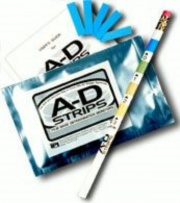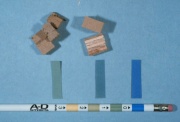A-D strips
Jump to navigation
Jump to search
Description
[Image Permanence Institute, Rochester, NY] A trademark for indicator strips designed to detect volatile acidic components released by the decomposition of Cellulose acetate. A-D, or Acid Detector, strips contain a PH sensitive dye (Bromcresol green) that changes from blue to green to yellow in the presence of any acidic vapors. The color reading, taken within 24 hours of exposure, is compared to a chart provided with the strips. The strips were developed by Fischer and Reilly (1995), who were honored with an Academy Award in 1997 for their contribution to the preservation of the history of motion pictures.
Synonyms and Related Terms
Acid Detector strips; AD-Streifen (Deut.); indicator strip
Risks
- Exposure to light will fade the colorant.
Physical and Chemical Properties
- RH should be about 50% for optimum results.
Resources and Citations
- A-D strips: Website
- J.Reilly, D.Nishimura, E.Zinn, New Tools for Preservation. Assessing Long-Term Environmental Effects on Library and Archives Collections, The Commission of Preservation and Access. Washington DC, 1995.
- M.C. Fischer, J.M. Reilly, "Use of Passive Monitors in Film Collections," in Topics in Photographic Preservation: Photographic Materials Group, AIC, 6, 1995 p.11.
- Catherine Nicholson, Elissa O’Loughlin, "The Use of A-D Strips for Screening Conservation and Exhibit Materials." AIC, Book and Paper Group: The Book and Paper Group Annual: volume 15, 1966.
- Pam Hatchfield, Pollutants in the Museum Environment, Archetype Press, London, 2002

